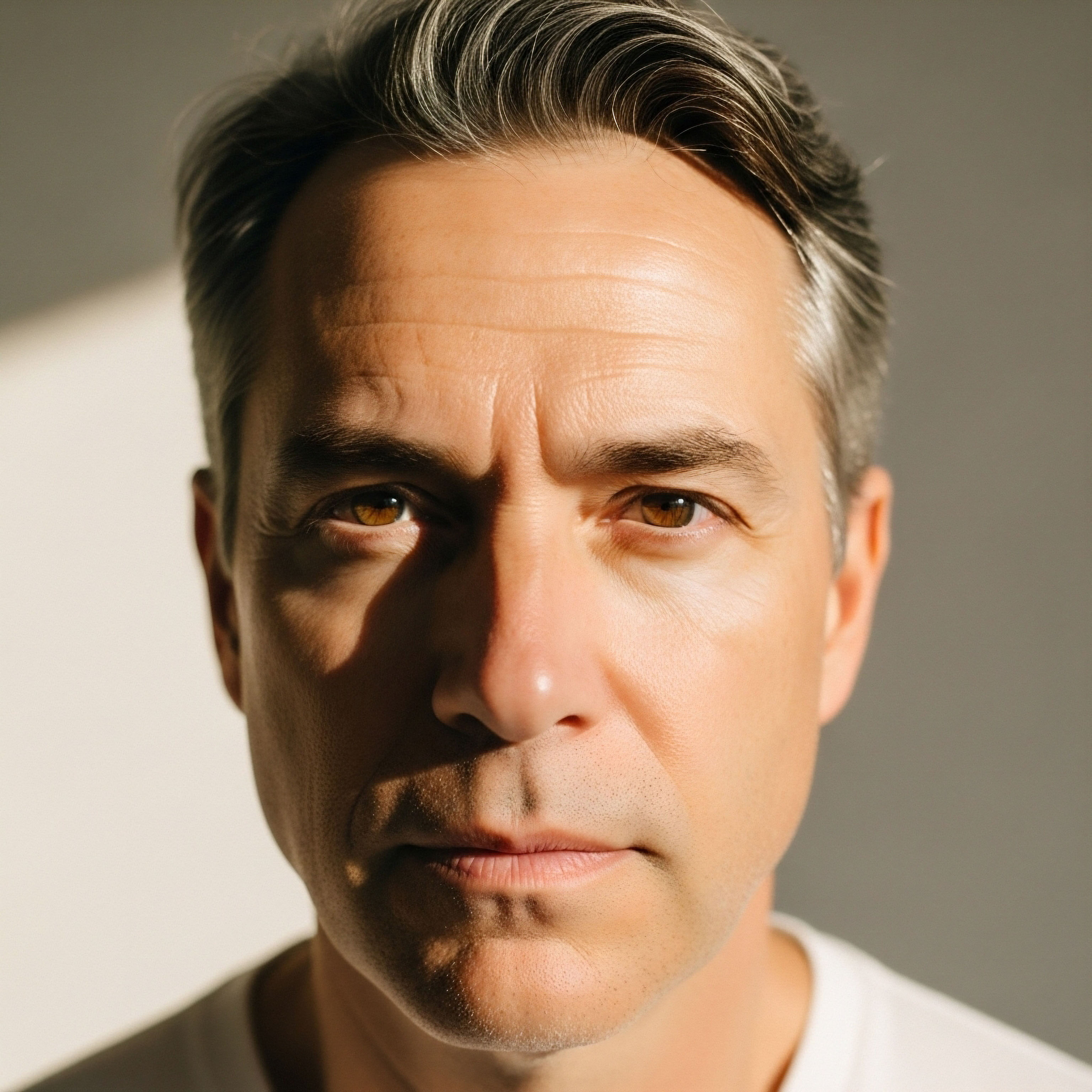

Fundamentals
When you feel the pervasive fatigue, the mental fog, or the loss of vitality that can accompany low testosterone, seeking a solution is a powerful step toward reclaiming your life. The conversation often leads directly to testosterone replacement therapy (TRT), a protocol known for its ability to restore energy, mood, and physical function.
Yet, for many men in their reproductive years, a critical question arises, one that touches upon hopes for the future and the desire to build a family. You are right to pause and consider how these treatments affect your entire biological system, specifically your body’s intricate process for creating life.
The core of the matter rests within the body’s own elegant communication network, the Hypothalamic-Pituitary-Gonadal (HPG) axis. This system functions like a finely tuned thermostat. The hypothalamus in your brain monitors testosterone levels. When it senses they are low, it signals the pituitary gland, which in turn releases two key messenger hormones ∞ Luteinizing Hormone (LH) and Follicle-Stimulating Hormone (FSH).
LH directly instructs the testes to produce testosterone, while FSH is the primary driver of sperm production, a process called spermatogenesis. These two functions, producing testosterone and producing sperm, are deeply intertwined within the testicular environment.
Standard TRT protocols introduce testosterone from an external source, typically through injections, gels, or pellets. This approach is highly effective at raising blood testosterone levels and alleviating the symptoms of hypogonadism. Upon detecting this influx of external testosterone, the hypothalamus and pituitary glands respond by ceasing their own signals.
The brain perceives that there is more than enough testosterone circulating, so it stops sending LH and FSH to the testes. This shutdown of the body’s natural signaling cascade leads to a significant reduction, and often a complete halt, in both internal testosterone production and sperm production. The testes, no longer receiving instructions to work, may decrease in size and function.
Standard testosterone therapy effectively alleviates symptoms by supplying external hormones, which simultaneously suppresses the body’s natural signaling required for fertility.
This is where the distinction of fertility-sparing protocols becomes paramount. These advanced strategies are designed with a more holistic understanding of the endocrine system. Their objective is to alleviate the symptoms of low testosterone while preserving the natural, internal machinery of the testes.
Instead of replacing testosterone directly, these protocols use specific compounds to stimulate your body’s own HPG axis. They aim to encourage the pituitary gland to continue sending its crucial LH and FSH signals. This method supports the testes in producing their own testosterone and, critically, maintains the environment necessary for robust sperm production. It is a therapeutic path that honors the dual roles of the male reproductive system ∞ hormonal balance and procreative potential.


Intermediate
To appreciate the functional differences between standard and fertility-sparing hormonal optimization, we must examine the specific tools used in each protocol and their distinct biological impacts. The therapeutic choice hinges on the ultimate goal ∞ raising systemic testosterone, or raising testosterone while protecting testicular function. Standard TRT achieves the first objective directly. Fertility-sparing protocols achieve both through a more nuanced biochemical approach.

The Mechanism of Standard TRT
A standard TRT protocol typically involves the administration of exogenous testosterone, such as Testosterone Cypionate. This directly elevates serum testosterone levels, providing significant relief from hypogonadal symptoms. To manage potential side effects from the conversion of this excess testosterone to estrogen, an Aromatase Inhibitor (AI) like Anastrozole may be included.
Anastrozole works by blocking the aromatase enzyme, thereby controlling estrogen levels and mitigating issues like gynecomastia or water retention. The primary outcome is a hormonally balanced state from an external supply, which comes at the cost of endogenous production due to the negative feedback loop on the HPG axis.

Fertility Sparing Methodologies
Fertility-sparing protocols operate on a different principle. They stimulate the body’s own production mechanisms. These strategies can be used as alternatives to TRT or, in some cases, alongside it to mitigate its suppressive effects.

Selective Estrogen Receptor Modulators (SERMs)
One of the primary tools is a class of compounds called Selective Estrogen Receptor Modulators, with Enclomiphene or Clomiphene Citrate being common examples. SERMs work at the level of the hypothalamus and pituitary gland. They selectively block estrogen receptors in the brain.
Since the brain uses estrogen levels as one of its signals to gauge hormone production, blocking these receptors tricks the pituitary into believing that estrogen is low. In response, the pituitary gland increases its output of LH and FSH. This surge in gonadotropins travels to the testes, stimulating them to produce more of their own testosterone and to maintain spermatogenesis. This pathway effectively boosts testosterone levels without introducing an external hormone that would shut the system down.

Human Chorionic Gonadotropin (hCG)
Another vital component is Human Chorionic Gonadotropin (hCG). This compound is a biological mimic of Luteinizing Hormone (LH). When administered, it directly stimulates the LH receptors in the testes, compelling them to produce testosterone and maintain their size and function. hCG is particularly useful for men already on TRT who wish to preserve or restore fertility.
By providing an LH-like signal, hCG can keep the testicular machinery active even when the brain’s natural LH signal has been suppressed by exogenous testosterone. It effectively creates a bypass, ensuring the testes continue to receive a “work” signal.
Fertility-sparing protocols use compounds like SERMs and hCG to stimulate the body’s innate hormonal production, preserving the testicular environment required for spermatogenesis.

Comparing Therapeutic Approaches
The following table illustrates the key differences in the components and effects of these two distinct therapeutic strategies.
| Feature | Standard TRT Protocol | Fertility-Sparing Protocol |
|---|---|---|
| Primary Agent | Exogenous Testosterone (e.g. Testosterone Cypionate) | SERMs (e.g. Enclomiphene) or hCG |
| Mechanism of Action | Directly increases serum testosterone levels. | Stimulates the body’s own production of LH and FSH. |
| Effect on HPG Axis | Suppresses natural LH and FSH production. | Upregulates natural LH and FSH production. |
| Impact on Spermatogenesis | Inhibits or halts sperm production. | Maintains or enhances sperm production. |
| Common Ancillary Medication | Anastrozole (to control estrogen conversion). | May also include Anastrozole if estrogen rises due to increased testosterone production. |
The decision between these protocols is a clinical one, deeply tied to the individual’s life stage and personal goals. For men whose primary concern is resolving hypogonadal symptoms without immediate fertility plans, standard TRT is a direct and effective path. For those who wish to maintain the option of fathering children, or who are actively trying to conceive, a fertility-sparing protocol offers a sophisticated alternative that aligns with their reproductive health objectives.


Academic
A sophisticated understanding of male hormonal health requires moving beyond a simple model of testosterone replacement. It necessitates a deep appreciation for the intricate, dynamic regulation of the Hypothalamic-Pituitary-Gonadal (HPG) axis and the critical importance of maintaining intratesticular testosterone (ITT) concentrations. The fundamental divergence between standard androgen replacement and fertility-sparing protocols lies in their relationship with this axis and, consequently, their impact on the testicular microenvironment essential for spermatogenesis.

The Central Role of the HPG Axis and ITT
The HPG axis is a classic endocrine feedback loop. Gonadotropin-releasing hormone (GnRH) from the hypothalamus stimulates the anterior pituitary to secrete LH and FSH. LH acts on the Leydig cells of the testes to synthesize testosterone, while FSH acts on the Sertoli cells to support sperm maturation.
Crucially, the ITT concentration required for robust spermatogenesis is approximately 100 times higher than circulating serum testosterone levels. Standard TRT, by introducing exogenous androgens, elevates serum testosterone but creates profound negative feedback on the hypothalamus and pituitary. This suppression of GnRH, LH, and FSH leads to Leydig cell quiescence and a collapse in ITT levels, rendering the Sertoli cells unable to support sperm development. This iatrogenic hypogonadotropic hypogonadism is the primary mechanism by which TRT impairs fertility.

What Are the Pharmacological Strategies for Preserving Fertility?
Fertility-sparing protocols are, in essence, strategies to bypass or override this negative feedback loop. They are designed to preserve the high-concentration ITT environment. The primary modalities include SERMs, hCG, and, in some contexts, aromatase inhibitors.
- Selective Estrogen Receptor Modulators (SERMs) ∞ Compounds like clomiphene citrate and its more refined isomer, enclomiphene citrate, function as estrogen receptor antagonists at the level of the hypothalamus. By blocking the negative feedback signal that estrogen normally exerts, SERMs induce a sustained increase in the pituitary’s pulsatile release of LH and FSH. This endogenous gonadotropin surge stimulates both Leydig cell testosterone production and Sertoli cell function, thereby increasing both serum testosterone and preserving the ITT necessary for spermatogenesis.
- Human Chorionic Gonadotropin (hCG) ∞ As a potent LH analogue, hCG directly stimulates Leydig cells, promoting testosterone synthesis independent of the suppressed pituitary. Its use is particularly relevant in two scenarios ∞ as a monotherapy for hypogonadotropic hypogonadism or as a conjunctive therapy with TRT. When used with TRT, hCG provides the stimulatory signal to the testes that is otherwise absent, allowing for the maintenance of testicular volume and some degree of spermatogenesis. Studies have shown that co-administering hCG with exogenous testosterone can successfully maintain semen parameters in many men.
- Aromatase Inhibitors (AIs) ∞ In some cases of hypogonadism characterized by a high estrogen-to-testosterone ratio, AIs like anastrozole can be used. By blocking the peripheral conversion of androgens to estrogens, AIs reduce estrogen’s negative feedback on the HPG axis, leading to a modest increase in LH, FSH, and endogenous testosterone production. Their role is often as an adjunct therapy.
Advanced fertility protocols pharmacologically manipulate the HPG axis to maintain the high intratesticular testosterone concentrations that are obligatory for spermatogenesis.

Protocol Selection and Clinical Considerations
The choice of protocol is dictated by the patient’s specific condition and reproductive timeline. A man with secondary hypogonadism wishing to conceive may be an ideal candidate for SERM monotherapy. A man already stabilized on TRT who decides he wants to have children may have hCG added to his regimen.
A post-TRT protocol designed to “restart” the HPG axis often involves a combination of these agents, sometimes including SERMs like Tamoxifen alongside hCG, to stimulate the system from both the pituitary and testicular levels.
The table below provides a granular view of these protocols and their intended physiological effects.
| Protocol Component | Mechanism of Action | Primary Clinical Application | Effect on HPG Axis |
|---|---|---|---|
| Testosterone Cypionate | Direct androgen receptor agonist. | Symptom relief in hypogonadism (Standard TRT). | Strongly suppressive via negative feedback. |
| Enclomiphene Citrate | Estrogen receptor antagonist at the hypothalamus/pituitary. | Monotherapy for secondary hypogonadism with fertility desire. | Stimulatory; increases endogenous LH and FSH. |
| hCG (Human Chorionic Gonadotropin) | LH receptor agonist in the testes. | Conjunctive therapy with TRT to maintain testicular function; monotherapy for hypogonadotropic hypogonadism. | Bypasses the suppressed pituitary to directly stimulate testes. |
| Anastrozole | Inhibits the aromatase enzyme, blocking testosterone to estrogen conversion. | Adjunct to control estrogen levels in both TRT and fertility protocols. | Indirectly stimulatory by reducing estrogenic negative feedback. |
Ultimately, the distinction between these approaches reflects a sophisticated evolution in endocrinological practice. It marks a shift from a simple replacement model to a systems-based approach that respects the complex, interconnected functions of the male reproductive axis, allowing for the concurrent optimization of hormonal well-being and reproductive capacity.

References
- Herati, A. S. et al. “New frontiers in fertility preservation ∞ a hypothesis on fertility optimization in men with hypergonadotrophic hypogonadism.” Translational Andrology and Urology, vol. 9, no. 1, 2020, pp. 16-24.
- “TRT Fertility Protocol ∞ Preventing Infertility Risk with TRT.” Fin vs Fin, 2024.
- “What protocol maintains fertility in men undergoing testosterone replacement therapy (TRT)?” Dr.Oracle AI, 2025.
- Wenker, E. P. et al. “Preserving fertility in the hypogonadal patient ∞ an update.” Translational Andrology and Urology, vol. 4, no. 5, 2015, pp. 577-81.
- “A Guide to Men’s Fertility While on TRT.” Wittmer Rejuvenation Clinic, 2024.

Reflection

Charting Your Personal Health Trajectory
You have now seen the biological architecture that underpins male hormonal health and the distinct clinical strategies designed to support it. This knowledge is the first, most critical step. It transforms you from a passive recipient of symptoms into an active participant in your own wellness journey.
The path forward involves looking at your own life, your personal goals, and your vision for the future. Are you focused on reclaiming the vitality you feel you’ve lost? Are you planning for a family, now or in the years to come? The answers to these questions are yours alone, and they will help guide the conversation you have with a clinical expert.
Understanding these protocols is not about self-diagnosis. It is about becoming an informed collaborator in your own health. The data points from a lab report, combined with the lived experience of your symptoms and your personal aspirations, form a complete picture.
This integrated perspective is the foundation upon which a truly personalized, effective, and sustainable wellness protocol is built. The next step is a conversation, one where you can articulate not just how you feel, but what you hope to achieve, armed with a deeper understanding of the powerful biological systems at play.

Glossary

follicle-stimulating hormone

luteinizing hormone

sperm production

spermatogenesis

testosterone levels

hypogonadism

testosterone production

fertility-sparing protocols

pituitary gland

hpg axis

standard trt

serum testosterone levels

exogenous testosterone

negative feedback

anastrozole

selective estrogen receptor modulators

enclomiphene

human chorionic gonadotropin

hcg

fertility-sparing protocol

intratesticular testosterone

sertoli cells

leydig cells

serum testosterone

estrogen receptor modulators




